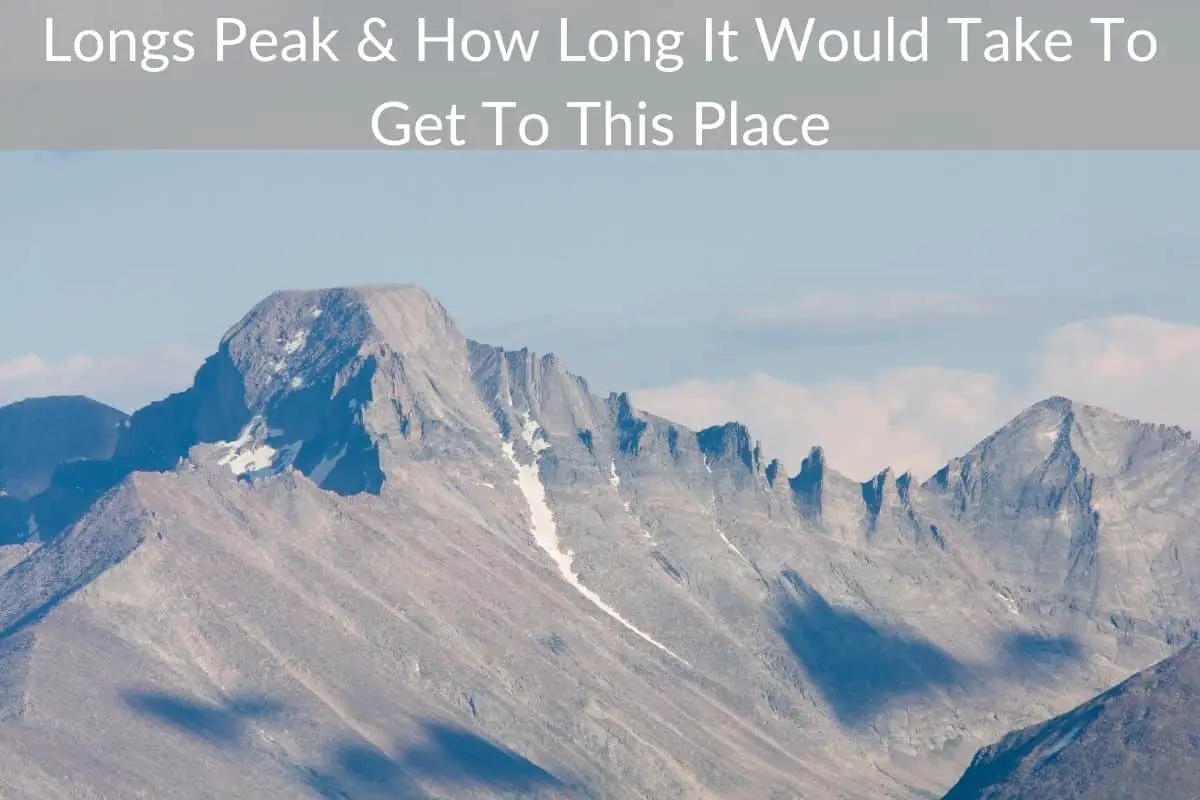Table of Contents
*This post may contain affiliate links. As an Amazon Associate we earn from qualifying purchases.
Longs Peak is without a doubt one of the best adventures the Rockies has to offer.
At a whopping 14,259 ft., this giant is one of the most beloved peaks in Colorado. Thanks to this impressive height and its unforgiving terrain, Longs Peak hike is one of the most difficult 14ers.
However, that doesn’t seem to stop hikers from attempting to conquer it.
Due to this reputation, Longs Peak is an enchantress to hikers looking to test their mountain abilities and gain some bragging rights.
However, with this lust, many hikers end up biting off more than they can chew.
Completed in a day, the main route, Keyhole, requires 5,000 ft. of elevation, 15+ miles of hiking, sun-bearing scrambling with a high fall risk and treacherous terrain above the treeline where storms tumble in regularly.
Sound like fun yet?
On top of that, summer days make this hiking trail packed with hikers of all shapes, sizes and abilities. From couch potato dreamers to serious athlete, many of which knock rocks down and create bottlenecks that prolong the torture even further.
If that isn’t enough encouragement to visit, over 60 people have died climbing Long Peak, the majority of which chose to venture up the Keyhole route.
Okay, hear us out before you run for your bed covers.
Long is an amazing mountain, however, it demands serious respect and seriousness.
If you’re planning on climbing Longs Peak, you should definitely consider these 10 facts about the climb that will help you create a safe, enjoyable, and strong experience on this beast of a mountain.
What You Should Know About Longs Peak Hike

If you’re still reading, congratulations!
You’re one of the brave ones.
Longs Peak is 4,346 m high with super tough terrain, scorching uncovered areas, unpredictable weather events and areas that require more scrambling than actual, ‘hiking’.
By reading through this important information and insight on Long Peaks, you’ll be able to better prepare yourself, making the experience more enjoyable and safe as opposed to semi-tortuous and quite treacherous.
So, without further ado, the top 8 facts you should know about Long Peak before you attempt to conquer it (and so it doesn’t end up conquering you)
1. OVER 50% OF HIKERS WHO ATTEMPT LONGS PEAK DON’T MAKE IT TO THE SUMMIT
Just to clarify — they end up making it down to the parking lot again, alive. They just don’t end up reaching the summit physically.
Rocky Mountain National Park stats report an average of 15,000 people attempting to climb to the top of Longs Peak every year. This includes all of the different routes.
However, out of 15,000 people, records show that roughly 47% of people are successful at actually reaching the summit.
This is due to late starts, weather, and underestimating the amount of physical fitness required for the hike.
While this may seem a bit disheartening, don’t let it deter you.
Although a humbling lesson, Longs Peak also teaches you a lot about yourself, whether you reach the summit or not. So keep an open mind, a humble heart, great courage, and the wits to know when it’s just not your day.
2. Longs Peak is Not Considered a Good First Fourteener
Many hikers make the mistake of using Longs Peak hike as their starting 14er.
Unless you have a lot of mountain climbing experience under your belt at high altitudes, chances are this hike will be a harsh reality.
Even while hiking at a decent pace, Longs Peak typically takes about 10 hours to complete. Many people will take 12-15 hours on the mountain.
If you’ve never done a 14er before, we highly suggest you start with something a bit less demanding.
Grays Peak, Mount Bierstadt, Torreys Peak or Handies Peak are much better 14er mountains to start of with.
While there are many reasons for this, one of the biggest reasons is due to the amount of top-class scrambling required while climbing Longs Peak.
Even though the trail is marked well, it’s quite possible to lose your way.
By working your way up to Longs Peak, earning the challenge after completing a list of other feats, you’ll be able to enjoy the experience a lot more.
3. You Must Start Early
As in, you don’t want to be starting the Keyhole area of the hike anytime after 6AM.
From the parking lot, it’s 5.5 miles on a very long trail and a large boulder field before actually making it to the Keyhole.
Starting on the trail around 2-3 AM is considered the best time. However, if you end up winning a camping spot in the boulder field the night before, you can move that starting point forward a bit more, obviously.
Give yourself 12 hours round trip at least.
4. Longs Peak is Not a Great Place to Bring Your Visiting Friend for a Lil’ Hike
If you live near Longs Peak, you may have people visiting who have heard of this well-known Colorado summit, and who may show interest in hiking it due to its fame.
However, unless your pals are fit and experienced, there are lot of other summits in the area that work much better as an enjoyable hike.
Let’s just say there won’t be any giggles or good conversation on this hike.
If your pal insists, try some warm-up mountains first.
5. Weather is Always an Issue
Weather can travel any time of any day with any type of forecast the horizon brings.
Over twenty people were hit by lightning in the Rocky Mountain National Park in 2014, which resulted in two deaths.
From the treeline below Chasm Lake to the summit, there are few places you can take cover in from an angry storm.
While there’s a small shelter at the bottom of the Keyhole proper, you’re basically exposed completed for many hours on end.
Make sure you start on the hike as early as possible and bring any rainproof clothes you have no matter what. Many storms can form out of the bluest of skies.
6. Trust the Rocky Mountain National Park Rangers’ Judgment
You’ll see rangers patrolling the area between the keyhole and the boulder field, ensuring everyone stays safe, offering assistance or help when needed.
These rangers are experts at Longs Peak in terms of its overall temperament. If they see rain, strong winds or storms coming through that seem dangerous to them, they’ll shut the trail down.
These guys know what they’re talking about, so don’t try to argue with them when it comes to your safety and possibly your life.
7. The Keyhole is an Extremely Crowded Route
During the weekends, you’ll find that the trail up towards Longs Peak looks more similar to a pilgrimage than a hiking route.
However, if you start early enough, chances are you’ll follow a uncrowded climb. However, you’ll be tossed into the mix once coming down.
Even though it’s a difficult mountain, many people still insist on trying it, despite whether or not they actually have the fitness or background to do well on the peak.
This created many bottleneck areas, particularly along the Homestretch and at the top of the Trough.
8. Harsh Reality: Once You Reach the Summit, Remember, You’re Only Halfway Finished
One of the harshest and most important things to remember when climbing Longs Peak is once you’re at the summit, you’re only halfway finished.
It’s easy to get caught up in the beauty and false sense of relief that comes with reaching the top. While the descent may be easier with other hikes, on Longs Peak, it’s probably more difficult than climbing up.
Making it back to the Keyhole area demands concentration and careful footing.
With this in mind, make sure you fuel up at the top with water and food so that you’re back in tip-top shape on the way back down.
Once you reach the trees after the boulder field, you can relax and congratulate yourself with an enjoyable hike back to the parking lot.
Final Thoughts on Longs Peak

Now, if you’re still reading along and your interest in conquering Longs Peak hasn’t faded, even after understanding its ins-and-outs, and what it demands of you, then you deserve to give it a try.
As one of the most beloved and well-known peaks in Colorado, you should attempt it at some point in your life.
All you need to do is make sure you’re well-prepared: mentally and physically.

